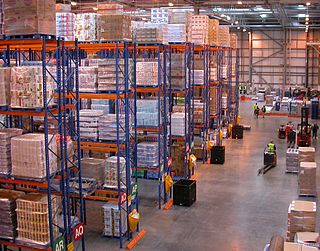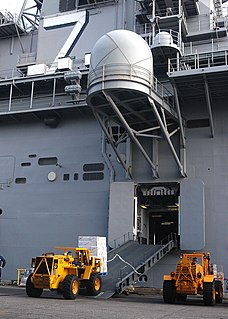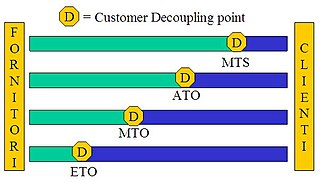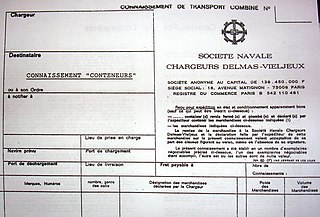Supervisory Control and Data Acquisition (SCADA) is a control system architecture that uses computers, networked data communications and graphical user interfaces for high-level process supervisory management, but uses other peripheral devices such as programmable logic controller (PLC) and discrete PID controllers to interface with the process plant or machinery. The use of SCADA has been also considered for management and operations of project-driven-process in construction.

Logistics is generally the detailed organization and implementation of a complex operation. In a general business sense, logistics is the management of the flow of things between the point of origin and the point of consumption in order to meet requirements of customers or corporations. The resources managed in logistics may include tangible goods such as materials, equipment, and supplies, as well as food and other consumable items. The logistics of physical items usually involves the integration of information flow, materials handling, production, packaging, inventory, transportation, warehousing, and often security.
A distributed control system (DCS) is a computerised control system for a process or plant usually with a large number of control loops, in which autonomous controllers are distributed throughout the system, but there is central operator supervisory control. This is in contrast to systems that use centralized controllers; either discrete controllers located at a central control room or within a central computer. The DCS concept increases reliability and reduces installation costs by localising control functions near the process plant, with remote monitoring and supervision.

Logistics automation is the application of computer software and/or automated machinery to improve the efficiency of logistics operations. Typically this refers to operations within a warehouse or distribution center, with broader tasks undertaken by supply chain management systems and enterprise resource planning systems.

A distribution center for a set of products is a warehouse or other specialized building, often with refrigeration or air conditioning, which is stocked with products (goods) to be redistributed to retailers, to wholesalers, or directly to consumers. A distribution center is a principal part, the order processing element, of the entire order fulfillment process. Distribution centers are usually thought of as being demand driven. A distribution center can also be called a warehouse, a DC, a fulfillment center, a cross-dock facility, a bulk break center, and a package handling center. The name by which the distribution center is known is commonly based on the purpose of the operation. For example, a "retail distribution center" normally distributes goods to retail stores, an "order fulfillment center" commonly distributes goods directly to consumers, and a cross-dock facility stores little or no product but distributes goods to other destinations.

Computer-integrated manufacturing (CIM) is the manufacturing approach of using computers to control entire production process. This integration allows individual processes to exchange information with each other and initiate actions. Although manufacturing can be faster and less error-prone by the integration of computers, the main advantage is the ability to create automated manufacturing processes. Typically CIM relies of closed-loop control processes, based on real-time input from sensors. It is also known as flexible design and manufacturing.

An automated storage and retrieval system consists of a variety of computer-controlled systems for automatically placing and retrieving loads from defined storage locations. Automated storage and retrieval systems (AS/RS) are typically used in applications where:
Industrial control system (ICS) is a general term that encompasses several types of control systems and associated instrumentation used for industrial process control.
Material handling equipment is mechanical equipment used for the movement, storage, control and protection of materials, goods and products throughout the process of manufacturing, distribution, consumption and disposal. The different types of handling equipment can be classified into four major categories: transport equipment, positioning equipment, unit load formation equipment, and storage equipment.
IEC 60870 part 6 is one of the IEC 60870 set of standards which define systems used for telecontrol in electrical engineering and power system automation applications. The IEC Technical Committee 57 have developed part 6 to provide a communication profile for sending basic telecontrol messages between two systems which is compatible with ISO standards and ITU-T recommendations.

Material handling involves short-distance movement within the confines of a building or between a building and a transportation vehicle. It uses a wide range of manual, semi-automated, and automated equipment and includes consideration of the protection, storage, and control of materials throughout their manufacturing, warehousing, distribution, consumption, and disposal. Material handling can be used to create time and place utility through the handling, storage, and control of material, as distinct from manufacturing, which creates form utility by changing the shape, form, and makeup of material.
Wave picking is used to support management and workers via a warehouse management system (WMS) in several ways, to support the planning and organizing of the daily flow of work of a warehouse or distribution center. Wave picking is an application of short-interval-scheduling. Managers, using a WMS, may assign groups of orders into short intervals called "waves", to initially simulate the flow for the day, consistent with the order departure plan and available labor. When the plan is satisfactory, it is accepted. The WMS will then release the waves to the warehouse sequentially throughout the day, to allow managers to coordinate the several parallel and sequential activities required to complete the daily work plan. One of the objectives of wave picking is to minimize the variation of workload in each work function by wave. The wave planning data includes the workload by order or function, providing management the information to calculate staff requirements to guide the assignment of staff by function, with the reasonable expectation that the work in each function, within each wave. Waves are often constructed to last between 1 and 4 hours, with resulting 8 to 2 waves in a shift.
Order processing is the process or work-flow associated with the picking, packing and delivery of the packed items to a shipping carrier. Order processing is a key element of order fulfillment. Order processing operations or facilities are commonly called "distribution centers".
Manufacturing execution systems (MES) are computerized systems used in manufacturing, to track and document the transformation of raw materials to finished goods. MES provides information that helps manufacturing decision makers understand how current conditions on the plant floor can be optimized to improve production output. MES works in real time to enable the control of multiple elements of the production process.
Distribution Center Management System (DCMS) is a user friendly Warehouse Management System (WMS), designed to track the activities performed in a Distribution Center (DC)/ Warehouse. It is created and owned by a private company called Eclipse Systems Pvt Ltd. It automates the entire process flow of receiving, managing and shipping goods to customers from the warehouse. DCMS solutions are designed for both large and small scale businesses. In January 2015, the product went open source.

Dematic is a supplier of integrated automated supply chain technology, software and services. With a growth rate of 25% in 2016 Dematic is listed as the world's third-largest materials handling systems supplier. The company employs over 6,000 people and has engineering centres and manufacturing facilities in the United States, Mexico, Australia, Germany, Italy, China and Czech Republic. Its customer base includes small, medium and large companies.
Warehouse Execution Systems (WES) are computerized systems used in distribution operations (Logistics) and are functionally equivalent to a manufacturing execution system or MES. Distribution operations are a form of a manufacturing operation that receive, store and track inbound material and then select and combine (assemble) various materials to form a finished product, order, or shipment.
Omnichannel Order Fulfillment is a material handling fulfillment strategy and process that treats inventory as fully available to all channels from one location. While the internal fulfillment process may diverge to optimize the operations, the outbound process only diverges at the point of pack out and shipping.












